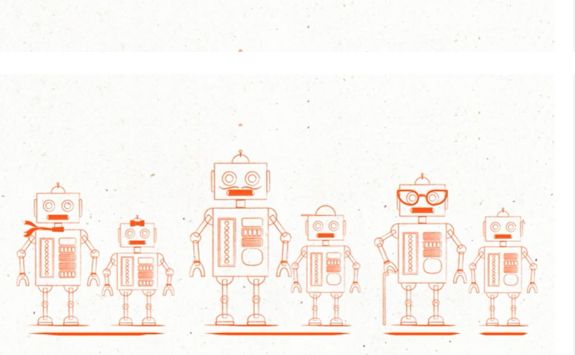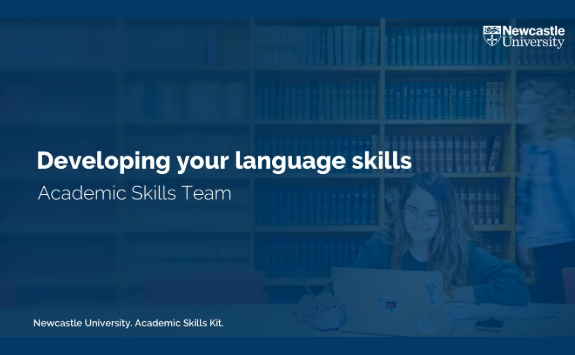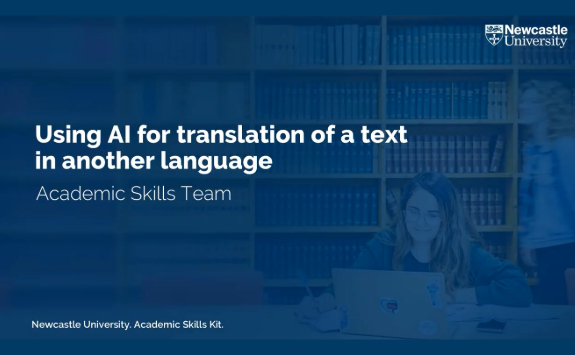Using AI for Translation
Guidance for students using translation tools when English is not your first language.
The language of assessment
There is great potential to use translation tools such as Google Translate, Youdao Translate, and Baidu Translate as digital assistants both for your education and in your future workplace. Although using AI tools for translation may help you develop your language skills and enhance your learning, it is important to identify why you are using it, consider your motivations and if the use would be seen as good academic practice.
English is the language (unless otherwise stated) of assessment at Newcastle University. The University Regulations make it clear that as a student, you must be able to demonstrate you have the technical ability to communicate in English that reflects the level and content of your course. You are also expected to maintain good academic practice throughout your studies, and any work that you submit for assessment must be your own. Your submitted work is your way of demonstrating to the marker the skills and knowledge you have learned. That means that the use of any digital tool or service which does the work or edits the work for you, would be considered academic misconduct. This can have significant consequences for your degree.
What might acceptable use look like?
You can use translation tools as digital assistants for your learning, but you must always be cautious about the accuracy of the outputs and evaluate anything produced by AI.
| Acceptable use of translation tools | Explanation |
|---|---|
| Help you understand a task or assignment brief. | If you are unsure about the meaning of the task guidelines, submission process or the terms used in the marking criteria / rubric. |
| As a dictionary to develop your knowledge of specialist vocabulary used in your subject. | Many subjects use technical or discipline specific terms that may be unfamiliar even to those with English as a first language. Translation tools will help you define these terms in your native language. You can then use this information and knowledge moving forward in your course. |
| Help you understand and develop your knowledge of a target language. | Translation tools can be used to translate a word, expression or short phrase when reading and writing. You could compare different translations to the original text, identifying vocabulary and comparing the grammar. |
| Help you with comprehension. | Translation tools can be used to support your ability to identify the meaning of a text. Comparing different translations may also help here. |
What might unacceptable use look like?
| Unacceptable use of translation tools | Explanation |
|---|---|
| Writing your work in your native language and translating it into English before submission. | Any work that you submit must be your own and submitting work that has been entirely generated by a digital tool or human translator will not reflect your own learning. |
| Including large sections of text within your assignment that you have generated using an AI or translation tool. | Submitting translated text that is more than a few words would be considered misconduct because the content has been generated by a third-party. |
| Using the output of an AI translation tool without evaluating it fully. | When using any digital tool or generative AI you must evaluate it critically, review the output for accuracy and appropriateness. Often content created by these tools may include fabricated information or be written in a style or tone that is not appropriate for writing at university. |
Using AI to translate information sources
When reading around a topic you may find books, chapters or articles in an unfamiliar language. Generative AI could help you access these sources and expand your knowledge. However, as you are not reading the original text, you will need to critically evaluate the output carefully and use translations with caution to ensure you are maintaining good academic practice.
One of the main challenges is that translation tools can create literal outputs that fail to communicate the voice, feeling or meaning of the original text. As students of translating and interpreting will tell you, translation is more complex than simply changing words directly from one language to another. There are often cultural considerations which AI may not take into account, and there are subtle nuances and expressions used to convey meaning that translation AI tools cannot identify.
If you do not have a knowledge of the language you are translating from, it will always be difficult to check the accuracy of any output. For primary texts, be sure to use a published translation recommended by your tutors, or for books and articles, consider if the content can be found in a language you understand. This will help you think critically about what you include in your work.
Tone and meaning
Many translation tools, including when Generative AI is prompted to translate text, act quite simply by translating the words used for a closest equivalent. They will rarely consider the cultural connotations, the tone or meaning of the language itself.
This video shows an example of how translation tools may miss out on the subtleties of meaning.
How could you use AI to improve your language learning?
AI and translation tools can help you develop the skills you need for university study and as a language learning aid. They can help you improve your overall language proficiency by:
- comparing translations to the original text so that you can check your understanding of new vocabulary.
- observing how grammatical structures are constructed and compare these with your own language.
- checking pronunciation of words and phrases, which will help build listening confidence.
- checking whether a word/phrase is appropriate in a particular context.
- helping you to identify the types of errors you tend to make in your work and provide suggestions on how to address these.
- helping you identify whether you have used an appropriate tone or level of formality in a particular context.
You can check your own understanding of what you’ve translated by thinking about whether you could explain the key ideas in your own words.
Prompts to help you
Using Generative AI with some well thought out prompts could be used to help you develop your understanding of the language and improve your proficiency, while avoiding relying on the tools too much to the detriment of your own learning, or the risk of academic misconduct. Avoid using over simplified prompts such as translate this for me into English. The example prompts might help you get started.
Example prompts
How can you say “X” [word/sentence/phrase] in English?
You are a first year undergraduate student in Biomedical Science. Provide a glossary of common scientific terms in English for use in a laboratory with an example for each term to provide context.
What is the [industry] terminology for this [word/phrase] in [language].
What is the translation of this idiomatic expression in [language].
Is there an equivalent word for [word] in [language]. Provide two examples and a description of the context I could use it in?
Conversational prompts
One of the advantages of using AI tools for translation tasks is the ability to enter into a conversation with the tool using dialogic prompting with AI. Having a discussion with the tool will help you develop your own translation skills and improve your understanding of the language.
Prompt 1
What is the translation of this idiomatic expression in [language]
Follow up questions
Are there any alternative expressions that I could use?
Would that be an appropriate expression to use in a business report?
Prompt 2
Upload a paragraph of text you have translated for yourself.
How does my translation compare to the original? Highlight the differences between my translation and the original text.
Follow up questions
Why did you translate “X” [word/sentence/phrase] in that way?



